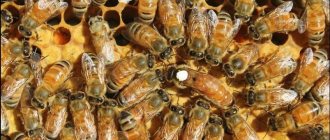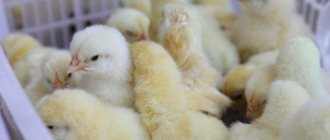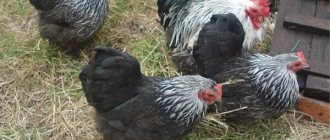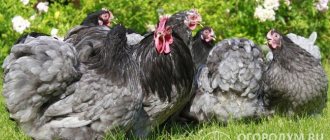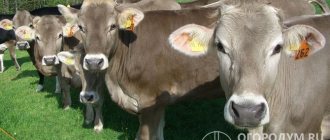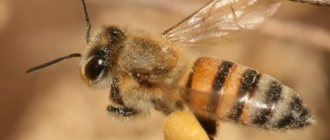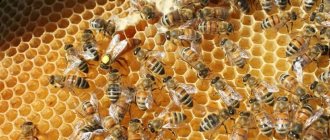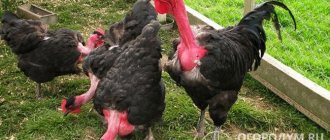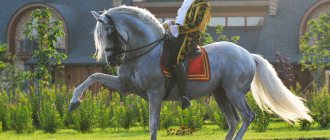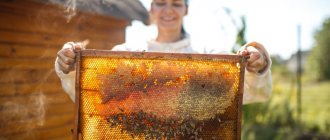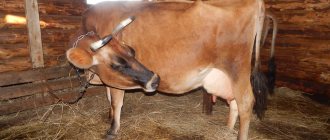Karnika bee breed - description and features
The breed of Karnika bees (another name is Krainka) was bred at the end of the 19th century in Slovenia, Duchy of Krajina, by crossing an Italian bee and a Cypriot drone . Since then, it has become widespread in Western and Eastern Europe, as well as in Russia. There are several strains of the Carnika breed - Hollesberg, Troyzek, Lower Austrian, Sklenar, Polish, etc.
Despite the slight differences, all of these strains have characteristic features :
- heavy weight – from 100 to 230 mg;
- proboscis length – 7-8 mm;
- thick-haired, silver-gray in color;
- numerous hooks on the rear wing;
- pointed abdomen , dark chitinous cover;
- signs of light-colored rims on the dorsal half rings.
Important ! Some varieties have yellow stripes on the first two or three tergites . The color of the chitinous cover can also change - from black to dark brown.
Queen bee
The size of the queen is approximately twice that of worker bees: the weight of a barren queen is 180 mg, and that of a fertile queen is 250 mg. The queen bee has a less shaggy abdomen and a dark brown body color with light brown stripes. The length of the wings is almost half the length of the body. Egg production reaches 1200-1400 pcs. per day (total weight – 350 mg).
Beekeepers, in their reviews of breeding Karnika bees, write that queen bees are replaced quietly , and for some time there can even be two queens at once. As a rule, a family lays two queen cells , which is enough for productive reproduction. If the temperature is +5°C, the queen may even begin to turn black in winter. Let us also note that the queen’s fertility has a positive effect on the early spring honey harvest - the bee colony has gained strength and is completely ready for it.
Expert opinion
Ponomarev Sergey Stepanovich
Beekeeper with 30 years of experience, Candidate of Technical Sciences
In autumn, scarring ends late - somewhere in November, when the air temperature remains at zero for three days.
Behavior of carnival bees
Insects have a peaceful and calm character. If necessary, you can calmly inspect the nest - the bees will not show aggression, the queen will continue to lay eggs, and the insects will remain on the frame. Karnika bees are also hardworking. They have a well-developed sense of smell and spatial orientation. They often attack, but at the same time reliably protect their hive from thieving bees. Roylivy, and this property is enhanced in the absence of a bribe - be sure to take preventive measures.
Therefore, karnik bees are not suitable for nomadic apiaries. Insects have adapted to flying in mountainous areas and are quite capable of collecting honey at an altitude of 1.5 km. Moreover, they fly out of the nest even in cool and cloudy weather. When the main honey flow arrives, bees limit brood . They are also excellent builders - the formation of honeycombs, even with a weak bribe, begins in early spring. First, the honey is stored in the brood part of the hive, and then in the store . Dry and white honey signet. When building honeycombs, insects hardly use propolis . Carnica bees require hives with vertical nesting extensions. Finally, they independently clean the house of varroa mites and wax moths.
How do they winter
Bees begin to prepare for winter early - after the end of the main summer season. If there is not enough pollen, laying and brood rearing are limited. Insects spend the winter in small families, and therefore consume food sparingly. There is no need to create special conditions - the bees live in a hive with a regular frame and walls 3.5-4 cm thick. The onset of spring is greeted with full energy, with clean nests and a minimum amount of waste . Bee colonies are increasing rapidly.
Note ! Karnika bees are characterized by high winter hardiness and endurance. At temperatures below -20˚С, insulation of the hives is required. 20-25 kg of food should be stored before the first flights for nectar .
Appearance of the Carpathian bee
Working individuals of the original Carpathian bee can be recognized by their gray body color; there is a silver edge on the abdomen. There is no yellowness. Bees of the Rakhovsky type have a slightly different color - dull silver. Maikop carpathian bees also have differences in appearance, which somehow managed to acquire a noticeable yellowness of the body, which is uncharacteristic of pure carpathian bees.
Drones are colored brownish and gray. The queen of the Carpathian bee can have several color options, from almost black to rich cherry.
The proboscis of worker bees reaches a length of 6.3-7 mm. One-day-old individuals weigh about 110 mg. The body width in the region of the third tergite is 4.8 mm.
The queen bee weighs about 210 mg at the exit from the queen cell, but by the beginning of oviposition she “fattens” to 216-218 mg. Its mass reaches its maximum at the moment of selection from the core - more than 230 mg.
Resistance of carnival bees to diseases
Karnika bees have high immunity to most diseases, as well as genetic resistance to honeydew toxicosis . If the winter is long and cold, insects may develop nosematosis . They are not susceptible to paralysis and acaropidosis. The queen bee and brood get sick quite rarely.
Resistance of carnival bees to diseases
In which regions is it recommended to breed?
Karnika bees are popular among beekeepers in Switzerland, Germany, Slovakia, the Czech Republic, Romania, Austria, and Central Europe. Insects are able to live in regions with hot summers, cold winters and short springs.
On a note ! At first, the breed was distributed only in Europe, but due to its high adaptability to climatic conditions, it is successfully bred in central Russia, Altai, the Urals and Siberia.
Origin
A German beekeeper in the name of the breed linked its origin to two nearby regions - Carinthia and Carniola. Hence the double name - karnika-krainka. Carnica originated in the foothills of the Austrian Alps and spread to many European countries.
As a result of the fact that European beekeepers imported and kept not only these bees, but also Italian, Cypriot and some others, the breed turned out to be very mobile genetically. This affects the variability of some traits within the breed. Therefore, the conversation will be about the main, most stable characteristics exhibited by Krajina bees.
The origin of another breed - the Carpathian - is quite confusing. Some attribute it to the Krajina variety, others - to the descendants of Ukrainian steppe bees. These bees show similarities with these two breeds, but also have their own unique features.
In scientific literature, references to the peculiarities of Transcarpathian flyers began to appear in the Czech press only in the twenties of the twentieth century. Over time, several strains have been developed.
Productivity indicators
Insects are hardworking and can work on any bribe. The long proboscis makes it possible to collect nectar with low sugar content. Bees have no problem finding the best nectar source and switching to it. Works great on red clover.
Karnika bees are highly productive
Productivity is approximately 1.5 times higher than that of other bees. They also use early honey collection better than other breeds. If the weather is good, the initial productivity will reach 30 kg/ha. Studies were carried out, during which it turned out that carnival bees collect honey worse where the food supply is represented only by wild crops . In addition, it is worth noting that krains fly “to work” about 30 minutes earlier than other species.
Expert opinion
Ponomarev Sergey Stepanovich
Beekeeper with 30 years of experience, Candidate of Technical Sciences
It is important to protect Krajina bees from interbreeding with other species. Traits will be transmitted exclusively through purebred breeding.
Pros and cons of the breed
Karnika bees are popular due to their calmness and lack of irritability. Let's look at other strengths and weaknesses of insects.
pros
- high honey productivity;
- high wax production;
- hard work;
- production of large amounts of royal jelly ;
- savings in feed consumption;
- good immunity;
- independence of performance from weather conditions;
- excellent coordination;
- always clean and white honeycombs ;
- the brood develops quite quickly;
- simplicity and ease of transportation;
- high fertility;
- good adaptability.
Minuses
- swarming with low honey flow;
- late blackening in the warm autumn, due to which food is overused and the bees wear out;
- insects hardly produce propolis;
- high cost;
- genetic instability;
- random filling of several frames with brood, which creates certain inconvenience for the beekeeper ;
- restriction of the queen bee in scarlet.
Note ! Beekeepers, having tried to work with Krajina bees, eagerly master their breeding.
Characteristic
Of course, there are individuals who are able to behave more angrily than usual, but this is not at all what aggressive representatives of the swarm are capable of. On average, carnivals are so calm that beekeepers work with them without smoke or protective netting, regardless of weather conditions. It is worth noting that when transporting hives with them for honey collection, the air temperature inside the dwellings rose much more slowly than for any other breeds. This means that even with constant shaking of their nests, insects behave very patiently.
Appearance
In terms of external color, this species is classified as gray bees, although they have small light brown corners on their bellies. This can be seen in the photo. In general, there are several disagreements on this topic, however, no one has canceled the official membership in this class. This variety is a hybrid bred in Germany. The basis for the carnika was an Italian bee; there is an admixture of Cypriot bee, but it is unknown what other Western European admixtures were involved.
Swarminess
The current breed has a specific feature - relatively high agility. The fact is that a century ago such a parameter was considered positive, since it was the key to boosting industry. However, in today's time this is more of a disadvantage than an advantage. Although swarming can be kept under control without any particular difficulties. Nevertheless, you should be prepared for this process already in the second half of July. You can knock it down simply - just place additional frames for adjustment in the nest. However, it is not worth placing them from the outside, or from the edges of the nest, since they practically do not inhabit them.
Genetic instability
Another feature of this subspecies is genetic instability. The fact is that alien drones cannot convey their information to them, so the qualities of the entire line are often lost. But with purebred breeding, the insect retains all the characteristics of its families. If the breeds are still mixed, then only the dominant feature will be inherited, and in the Karnika this is calmness and gentleness.
Development of offspring
In addition, these bees have early development of their offspring: their offspring mature earlier than most other species. This becomes one of the factors why in the spring the swarm begins to increase its strength very quickly. The greatest effect occurs in the months from May to May. But the queen lays eggs only as long as they bring pollen. As soon as you stop, the development of the family goes into decline. This distinctive feature makes it possible for the Karniki breed to winter only as part of a small family. Although the overall strength of the families is not particularly powerful, it is rather average. In addition, the current hybrid, during a severe and cold winter, coupled with early spring, becomes highly susceptible to nosematosis.
Flaws
The disadvantage of this type is also that it produces almost no propolis. Only a few carnica-based hybrids living in southern Europe are capable of reproducing at least an average amount of this building material.
Advantages
But the property of the entire species is the least gluttony among all known bees. This means that during wintering, the least amount of feed is spent on them. And all the bees that eat little food come out after wintering in very good condition. In addition, they perfectly rebuild cells, even in the case of a weak bribe. Although insects are often very reluctant to remove the foundation. The signet of the carnika is very close to dry and light in color.
Change of queens
The current variety tends to quietly change queens, and they lay no more than two queen cells
This is another reason to be wary of swarm queens.
Peculiarities
A physiological feature of the carnika is considered to be a fairly long proboscis. Its average length is 6.6 millimeters, and sometimes this parameter reaches 6.8, which is only slightly inferior to high-mountain bees. This means that insects can get nectar and bee pollen even from hard-to-reach places. Almost the entire body of the insect is covered with a dense layer of light yellow color. Learn more about carnika bees in the video below.
Reproduction of Karnika bees
Karnika bees are characterized by intensive spring development, they quickly increase the strength of colonies and work on early honey plants. In the event of a return spring cold snap, they do not reduce the rate of brood rearing, using even scarce sources of nectar and pollen . To do this, they fly out of the hive even at a temperature of +10˚С.
The family loses many adult flying bees; soon they are replaced by a sufficient number of young individuals. In the case of a harsh and long winter, reproduction may begin late, and by the beginning of the main honey flow, the strength of the swarm will be low. If the queen stops receiving pollen, she stops producing brood. For its proper and healthy development, the temperature in the hive should be within +32-35˚С.
Swarminess
A characteristic feature of purebred bees is the tendency of insects to be very swarming. In the spring, active reproduction and growth of family strength occurs. The absence of an early bribe, a decrease in the production of biologically active substances in the queen (pheromone, which bees lick from her body, suppresses the growth of the ovaries of workers and stimulates the growth of their throat and wax glands) leads the family to a swarming state.
Preventing such a process does not cause difficulties and only requires the timely adoption of a number of actions by the beekeeper:
- reducing the amount of light entering the hive, increasing ventilation;
- expansion of the nest with enclosure of the uterus;
- substituting frames, breaking out queen cells.
Karnika responds well to such measures and easily emerges from swarming. The strains of the breed (Pesch, Sclenar, Varroatolerant) are not prone to swarm formation.
Breeding Features
In reviews of karnika bees, beekeepers point out their unpretentiousness and low purchase and maintenance costs, which more than pay for themselves in a short time.
Karnika - the most peaceful and powerful bees
Bee packages with the carnika family are purchased in special stores. The kit includes:
- 3 dadan frames with larvae and 1 covering frame;
- Karnika bee family;
- queen bee under 1 year of age with a mark on the back;
- food – kandi flatbread weighing 1.5 kg;
- water with a special, insect-friendly drinking device;
- package.
On a note ! In March-May, carnika bee colonies develop rapidly, the highest peak being June-July. They create large families; the nest can occupy up to 3-4 buildings.
Good advice on content
Before purchasing Karnika bees, you should find out which strain is best suited for a given region. Some are good for early spring bribes, others - for summer ones. The productivity of the family will increase significantly if the Krajina queen is kept together with drones of the Italian breed. The apiary can be kept on both flat and relief terrain. Periodically, you need to invite a veterinarian to examine the insects. Suitable for nomadic apiaries - they easily settle into a new place and do not fly into other people's hives.
It is important to provide the bees with water to save their energy. In hot weather, the ventilation holes in the hive should be opened. For productive beekeeping, karnik strains require maintaining the purity of the breed; when crossed with other species (even intrabreed strains), they lead to loss of breeding qualities.
Queen bee buckfast
The queen bee buckfast shows the development of reproductive function. This allows eggs to be laid without interruption, which leads to the gradual growth of the family. The average number of future offspring is 1900–2000 eggs per day. The scarring continues in the fall, preventing the family from weakening.
Nest construction occurs only on the lower floors of the hive. It stands out for its compactness and neatness. Queen bees will not move on to new combs until they completely fill the frame. To increase the size of the family, it is enough to periodically expand the nest.
The peculiarity of queen bees is that they are difficult to hatch. For example, out of a thousand individuals received, only 20 are suitable for breeding purposes. This leads to higher prices. It is difficult to find a real queen, since most of the breeding farms are located in Germany.
Comparison of several breeds
When choosing a bee breed for a given area, a beekeeper needs to take into account many factors - adaptability to climatic conditions, queen fertility, immunity, viciousness, and playfulness. Each breed prefers a certain range of plants for honey collection - this must be taken into account when analyzing the honey plants growing around. The Central Russian bee tolerates the long, harsh winter better than anyone else, but is aggressive and effective in the abundant short harvest. Focused on one type of flowering plants - most of all intended for the production of monofloral honey . Caucasian bees, on the contrary, easily switch from one honey plant to another and work well on weak bribes.
What is better - carnika or karpatka?
Beekeepers cannot decide which breed of the two is better. With many similar characteristics, Karnika bees demonstrate a number of advantages:
- higher productivity;
- work at low temperatures and during heat, in cloudy weather and even during light rain;
- protect the hive from wax moths, keep it clean;
- When necessary measures are taken, they easily come out of the swarm state.
Some lines of the Karnika bee breed have a hard time withstanding wintering, emerging from it very weakened, developing poorly, working slowly, in which they are inferior to the Carpathians . Living in one place for 5-6 years, krains can become extremely playful. Carpathian moths are more prone to theft and do not pay attention to wax moths. If a colony begins to swarm, it is very difficult to bring it into working condition.
Which is better - carnica or buckfast?
Buckfast is also characterized by high honey productivity, good immunity, economy and cleanliness. Not aggressive and not roaming. Karniks are inferior in frost resistance; they begin to fly around with the onset of warm weather, but they work better in humid weather. The queen fills the combs with brood in a continuous order and does not move on to other frames until one is completely filled. Buckfast bees, like carnika bees, need to expand their nest . It is convenient for the beekeeper to work with them - the honey is placed at the top of the nest or on the side. When choosing between buckfast or carnika breeds, you should take into account climatic conditions and economic factors - the former are more expensive.
Beekeepers' opinion
Reviews from owners who keep the Karnika bee.
Karnika is my favorite breed of bee. If I follow the rules of its maintenance, I receive excellent bribes, quickly develop the apiary, and increase the number of hives.
Igor, 54 years old
For me, as a novice beekeeper, the peacefulness of the carnika became the key when choosing. It is a pleasure to work in an apiary, knowing that a “guard” bee will not sting into you.
Alexander, 42 years old
The thrifty, kind-working Krainsky breed of bees is a godsend for every beekeeper. Even if it is inferior in bribes to the Central Russian one, but in combination with other characteristics, you can turn a blind eye to this. A big plus: the bee does not “walk” through other people’s hives, and will not give offense to its own.
Oleg, 64 years old
When choosing a breed of bees for your apiary, you should pay attention to Karnika. If you learn to deal with her minor shortcomings (swarming and genetic instability), you will get an active worker who will provide an excellent bribe and rapid family growth
FAQ. Questions and answers
When did the Karnika breed appear?
The breed of Karnika bees (another name is Krainka) was bred at the end of the 19th century in Slovenia, Duchy of Krajina, by crossing an Italian bee and a Cypriot drone. Since then, it has become widespread in Western and Eastern Europe, as well as in Russia. There are several strains of the Carnika breed - Hollesberg, Troyzek, Lower Austrian, Sklenar, Polish, etc.
What does a queen bee look like?
The size of the queen is approximately twice that of worker bees: the weight of a barren queen is 180 mg, and that of a fertile queen is 250 mg. The queen bee has a less shaggy abdomen and a dark brown body color with light brown stripes. The length of the wings is almost half the length of the body.
How do Krajina bees behave?
Insects have a peaceful and calm character. If necessary, you can calmly inspect the nest - the bees will not show aggression, the queen will continue to lay eggs, and the insects will remain on the frame. Karnika bees are also hardworking. They have a well-developed sense of smell and spatial orientation.
What is the productivity of carnika bees?
Productivity is approximately 1.5 times higher than that of other bees. They also use early honey collection better than other breeds. If the weather is good, the initial productivity will reach 30 kg/ha.
DIY bee deck
DIY Dadan hive
Keeping Bees for Beginners
DIY hive frames
Varieties
Breeding work with carnica has made it possible to develop several varieties that are offered to buyers on the market. The main varieties of this bee are:
- Pawner;
- Sklenar;
- Karnika Troizek (Holland);
- Troizek Celle;
- Troyzek Latbush;
- Varroatolerantz;
- Hollesburg;
- Lower Austrian line.
Here is a brief description of each variety.
Pawn
This strain is quite old and well-known. It is characterized as one of the most numerous. The main character trait is peacefulness. It swarms well and has a wavy development.
Sklenar
Perhaps the only variety that has a rather aggressive character. For this reason, this subspecies is not used for further crossbreeding, since the result is a breed of bees with a very high bitterness. This variety is used in the later stages of honey planting.
Troyzek
This subspecies is the oldest in the breeding lines. Shows fairly low swarming, great cleanliness and peacefulness. Development occurs gradually and reaches maximum growth in early and mid-summer.
This variety is the merit of German breeders and the breeding material belongs entirely to them. They are distinguished by incredible calmness and good perseverance on the frame. Peak colony development is achieved in mid-summer. They are usually large and one nest can occupy several buildings.
Troizek Celle
The name of this variety comes from the Celle Institute where the strain was developed. This line is constantly evolving, so new subspecies are constantly appearing on the market. Like the rest of the breed, they are very calm. With a sufficiently long and correct selection, there is no need to use protective equipment and smoke.
Troyzek Latbush
A fairly calm species that swarms weakly. However, once the queen turns three years old, the threat of swarming increases. The subspecies is not used in breeding work.
Hollesburg
This variety is characterized by strong families. Along with its rather peaceful character, this strain shows high productivity during honey collection.
Lower Austrian Line
This subspecies was created by crossing a variety of northern bee and carnika. A distinctive feature is that in winter families practically do not weaken. They are sensitive to space and comfort, so they require spacious hives.
